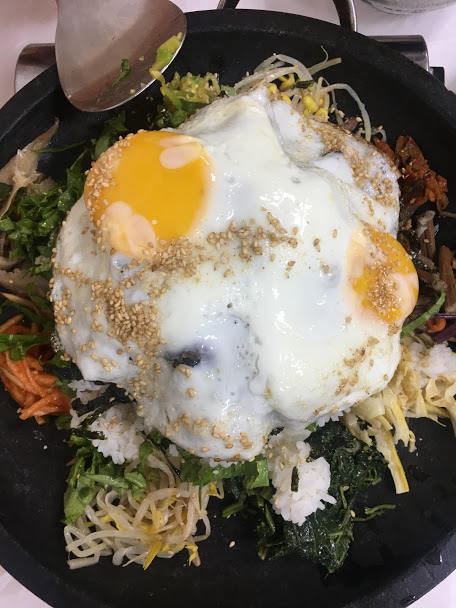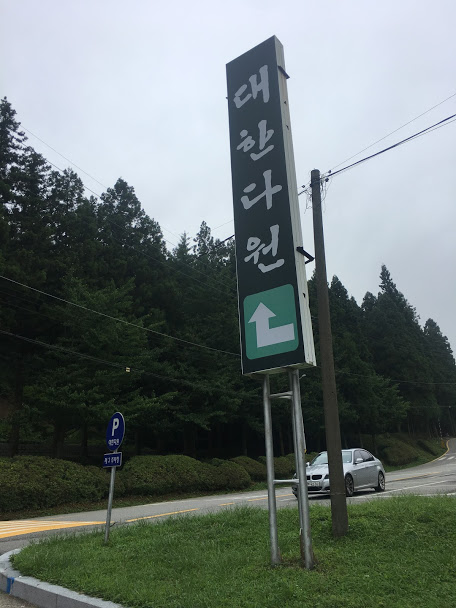Last Updated on August 15, 2019 by travelingwithsunscreen
We decided to spend a few days in Korea visiting smaller cities in the south and the Boseong Green Tea Plantation (Daehan Dawon). This turned out to be a great choice. The towns and cities that we visited in the south were far less crowded and touristy than Seoul, and the tea farm at Boseong was beautiful! Here’s everything you need to know.
Getting to Boseong from Seoul
We read online about several people doing Boseong as a daytrip from Seoul, but this seems crazy. You’ll spend an hour or two at the tea fields, and about ten hours traveling there and back. We did it as a three day, two night trip and visited Gwangju, Jangheung, and Boseong.
First, we took a bus to Gwangju. This was very easy. We purchased tickets from the handy, English-speaking, foreign-credit-card-accepting machines in the Seoul Express Bus Terminal. Tickets were about $18 USD each. We bought them a day in advance, but we really needn’t have done so; when you board the bus there is a screen that shows which seats have been reserved and which haven’t, and the Koreans boarding the bus were definitely buying their tickets right before boarding. Buses to Gwangju leave several times an hour, although the cheapest economy bus only leaves about once an hour. (The other buses are only a few dollars more expensive, though). The bus ride is about 3 hours and 20 minutes (longer, in heavy traffic), and there is a rest stop about halfway through. Bear in mind that there is no bathroom aboard the bus.
We stayed overnight in Gwangju. There is not soooo so much to do there, compared to Seoul, but it’s interesting to see another, less tourist-oriented city. There were few Westerners there, aside from expats. We ate at a lovely vegetarian buffet and spent the evening wandering Gwangju’s small pedestrian area.
The Gwangju bus station is also very large and easy-to-use. We decided to visit another town before Boseong, but it is also possible to get a bus directly from Gwangju to Boseong. This costs about $10 USD and takes about an hour and a half, and tickets can be purchased from the friendly English-speaking, international-credit-card-accepting machines in Gwangju’s bus terminal. Too easy! This would be a great way to make a day trip of Boseong from Gwangju. You could stay overnight in Boseong if you wanted, but it’s not the most appealing town, and there’s nowhere to stay in the tea fields themselves, unfortunately.

Instead, we stowed our backpacks with the majority of our luggage in the lockers at the bus terminal and headed by bus to to the town of Jangheung. We knew nothing about this place, and had only decided to go so that we could stay at a very charming little countryside Airbnb we had found there. Our little guesthouse turned out to be great, and we enjoyed our afternoon and evening and Jangheung. There is a chain coffee shop, Droptop, with beautiful views of the river and mountains. We strolled along the river, and stumbled into a great restaurant with a very friendly owner and excellent bibimbap.

The only thing we were nervous about was getting a bus from Jangheung to Boseong. Our Airbnb host had advised taking a taxi for $40-$60 USD, which we were prepared to do if we couldn’t get a bus. But, we arrived at the bus terminal, worked out how to read the Korean on the ticketing machine well enough to purchase our tickets (about $5 USD each), and our bus immediately pulled into the station! (Buses to Boseong from Jangheung bus terminal leave from gate 3. Be on the lookout for the Korean name of Boseong displayed on buses as they pull in: 보성). We were there within the hour!
Getting to Boseong from Busan
This is even easier than getting to Boseong from Seoul! There is a direct bus between Busan and the Boseong bus terminal. However, we would still recommend visiting Gwangju, Jangheung, or other towns in the area. It’s a far journey to just see a single tea plantation!
Luggage storage at Boseong Bus Terminal
Unfortunately, there is nowhere to store your luggage at the Boseong Bus Station or at the tea plantation itself. Best to arrive in Boseong without heavy baggage, as you won’t want to lug it up and down the hill at Daehan Dawan Plantation!
Getting to the green tea fields
The Boseong bus terminal was by far the smallest we had yet encountered. There was, however, a handy posted schedule indicating the buses that went to the green tea fields (see below), and the drivers understood “green tea.” (They know what you’re there for, as a tourist, anyway.) You can pay for this bus with the same T-money card that you use in Seoul, Gwangju, and everywhere else in Korea. You can also apparently get a taxi for about $10 USD, but we wanted to do it just on public transit, if possible.

The bus drops you off near a giant parking lot. Go through the parking lot, and follow the signs with the arrows (see below). Eventually, you’ll come to the ticket window, and for just a couple of USD, you’re in!

What to expect at the green tea fields
We visited in late July, and it was hot. The green tea fields are built on a tall hill, and basically you climb up and around. They’re very beautiful, and it’s definitely worth it, but make sure you have a lot of water with you! The experience is even better because there really aren’t very many tourists, and even fewer that go up and around the whole loop. Overall, it takes one to two hours to loop up, around, and back.

When you get back to the bottom, there are zillions of green tea products for sale. We got iced green tea (very needed). Also very popular was the green tea ice cream. You can get your snacks and tea to go, but there is also a nice picnic area to sit and rest while still admiring the tea field. It’s a lovely way to enjoy the best of Korean green tea!
Afterwards, right outside of the entrance gate, we went to a restaurant at which we split a green tea bibimbap. It was okay, not great. But nice to sit in a cool room and rest up a bit!
Getting back to Gwangju (and Seoul)
To leave the green tea field, we had to go under an underpass from our original bus stop to the bus stop on the other side. Once again, we looked for buses with the Korean words for Boseong (보성) to find ones that ended at the Boseong bus terminal. From there, we used the (English-speaking) machine to buy our tickets back to Gwangju. (The last bus from Boseong to Gwangju is at about 8:30 PM). We spent the night in Gwangju and headed back to Seoul in the morning.
Overall, we’re really glad we did this mini-trip! It was a great way to see Korea outside of the major big cities, and the tea fields themselves were beautiful!
Have you been to Boseong? Do you have any tips? Let us know in the comments below!
You might also be interested in:
Vegetarian Restaurants in Seoul: the best of the best!
Ultimate Packing List (for anywhere in the world!)
How can I afford a trip to Paris – or anywhere?

